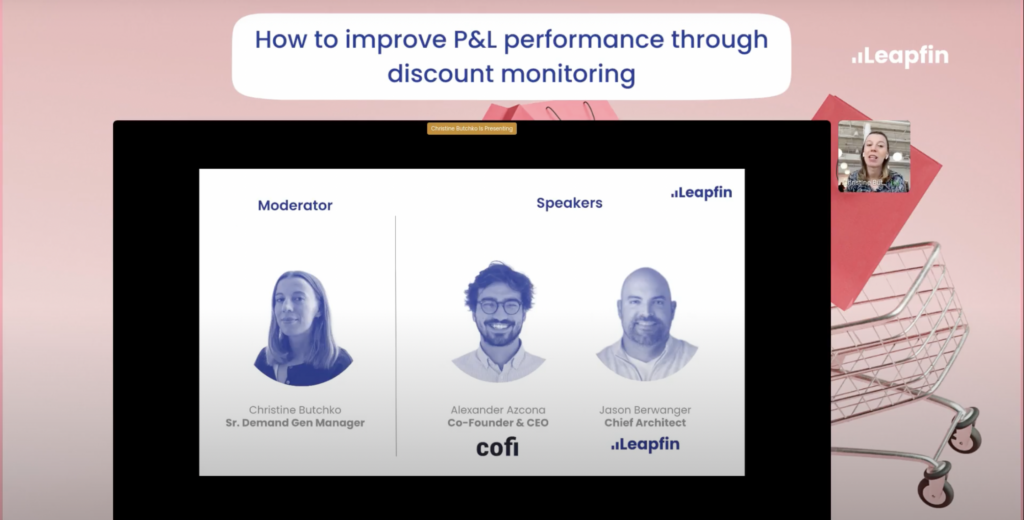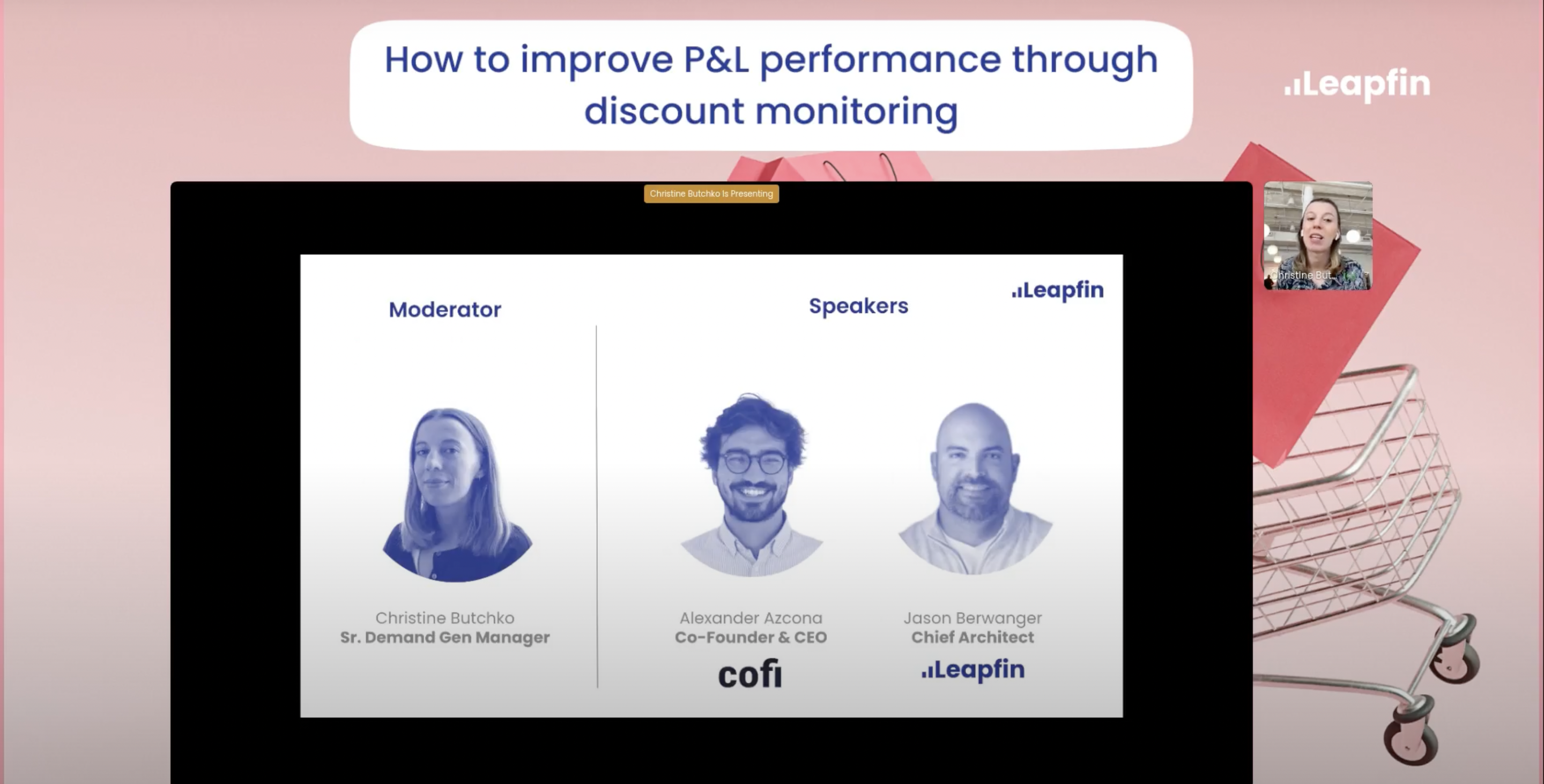According to a study by Bain & Company, companies that focused heavily on price promotions experienced a decline of 1-2% in their earnings before interest and taxes or EBITA over a three-year period. Excessive discounting can erode profitability over time. That’s especially true if there’s no cohesive strategy in place to help operations and finance monitor it.
We discussed this topic and its ramifications during our last event “How to improve P&L performance through discount monitoring”, where I hosted and Alex Azcona, CEO and co-founder of FP&A software company Cofi.
We came to the conclusion that the following issues are preventing companies from understanding the real effectiveness of their discounted pricing:
- Lack of interdepartmental visibility into discounts across the company
- Siloed data about discounts in multiple sources of “truth” like the general ledger and subledgers, CRM, and other operational and finance tools
- No accountability for discounts and unclear organizational goals tied to them leading to too aggressive strategies
I pointed out a few examples of how this causes problems:
One example that I think I’ve seen is the multiple sources of the truth. Marketing shows one way to measure ROI and sales shows another. There isn’t any visibility in the order-to-cash process of what discounts were being used.
And so ultimately what companies see is that once they tie out their order to cash they uncover that there are a number of products and customer segments that are completely unprofitable. That happens because of discounting. Worst of all, it happened long before a lot of the operational costs were even considered.
You can’t under-invest in understanding and analyzing discounts because discounts often outweigh the Cost of Goods Sold or the actual expense of providing the service, particularly if you’re in SaaS software or any type of subscription business
Alex agreed and added:
There has to be a top-down strategy. You need very precisely defined guidance on how you are going to apply your discounts and who can apply them, and whose accountable for their effectiveness.
You don’t want to get into a situation where one discount has been applied multiple times for the same customer. Or you’re giving out lifetime discounts without understanding their real impact. Otherwise, discounts just become a forecasting nightmare. You’re trying to forecast what your financials are doing, but you’re also trying to understand LTV so that you can deduce how much to spend to acquire a customer. And obviously, those residual or recurring discounts will have a big impact on your LTV versus a one-time discount.

Measures to counter discounts eating into your profits
There are a few things companies can do to stay on top of discounts:
- Stacked discount rules – First, identify all the different types of discounts you’re offering. Think about how intend for those discounts to interplay with one another. If, for example, you have a bundled discount, are you analyzing profitability and are you forecasting profitability for those bundled discounts together? Are you working with your operational partners on how, and when should discounts should be stacked? Answering these questions is the only way you’re getting to the right outcome.
- Wallet expiration – Put some guard rails around the timeframe you allow for discounts to be used. You don’t want to get into indefinitely deferring them. This can turn into an accounting nightmare because you’re constantly tracking this on the balance sheet.
- Set customer service credit approvals and budgets and P&L performance incentives for operations – As Alex already mentioned, a top down strategy is crucial here. Discounts can’t just be handed out without a high-level idea of what your goals are. There have to be mechanisms in place to ensure you’re following a strategy rather than pursuing an all-out plan of attack that ends up eating away at your profitability.
Most discount-related issues are caused by a lack of organizational visibility as a result of working in multiple sources of the truth. Your customer service team might be looking at discounts one way and marketing another. Your CRM data might be different than your G/L data. What’s ultimately missing is strategic finance at the center of guiding those mechanisms towards their intended outcomes.
If finance doesn’t have the ability to measure that or be the glue to put together all of the departments, then you’re not going to get to the intended outcome. This lack of visibility almost always ends with losing profitability.
A way to simplify discount monitoring
In most cases, companies need a way to tie all their discounts back to a customer level. They need the ability to tell how discounts stack up as an overall percentage of their revenue share. A more granular view enables you to really understand what cohorts are performing well with discounts and how better to stack up discounts to increase your profitability.
Ultimately, I think a lot of finance leaders and accounting folks are really after this ability to see their finance and operational data in one place and be able to segment different parts of their business to understand how discounts are really impacting profitability.
After all, it’s a lot easier to hold folks accountable when you have full visibility into your data. This is what motivated us to create the Leapfin Finance Data Platform.
Leapfin ingests all your operational data and embeds it into an interconnected network you can “surf along” and drill into. We’ve made it easy to analyze your business from one place and segment, say, discount ratios, based on product line, location, and other filters.
Instead of pulling data from multiple sheets and reverse engineering numbers, you can see discount ratios and their effect across segments in just a few clicks.
Curious to learn more about the Leapfin Finance Data Platform? See our platform overview here. Or, if you’d like to learn how your team can improve your OTC process with Leapfin, schedule a consultation with me.
See how Leapfin works
Get a feel for the ease and power of Leapfin with our interactive demo.
